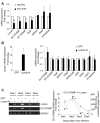Luman is involved in osteoclastogenesis through the regulation of DC-STAMP expression, stability and localization
- PMID: 26503158
- PMCID: PMC4712816
- DOI: 10.1242/jcs.176057
Luman is involved in osteoclastogenesis through the regulation of DC-STAMP expression, stability and localization
Abstract
Luman (also known as CREB3) is a type-II transmembrane transcription factor belonging to the OASIS family that localizes to the endoplasmic reticulum (ER) membrane under normal conditions. In response to ER stress, OASIS-family members are subjected to regulated intramembrane proteolysis (RIP), following which the cleaved N-terminal fragments translocate to the nucleus. In this study, we show that treatment of bone marrow macrophages (BMMs) with cytokines - macrophage colony-stimulating factor (M-CSF) and RANKL (also known as TNFSF11) - causes a time-dependent increase in Luman expression, and that Luman undergoes RIP and becomes activated during osteoclast differentiation. Small hairpin (sh)RNA-mediated knockdown of Luman in BMMs prevented the formation of multinucleated osteoclasts, concomitant with the suppression of DC-STAMP, a protein that is essential for cell-cell fusion in osteoclastogenesis. The N-terminus of Luman facilitates promoter activity of DC-STAMP, resulting in upregulation of DC-STAMP expression. Furthermore, Luman interacts with DC-STAMP, and controls its stability and localization. These results suggest that Luman regulates the multinucleation of osteoclasts by promoting cell fusion of mononuclear osteoclasts through DC-STAMP induction and intracellular distribution during osteoclastogenesis.
Keywords: Cell-cell fusion; Endoplasmic reticulum; Osteoclastogenesis; Transcription factor.
© 2015. Published by The Company of Biologists Ltd.
Conflict of interest statement
The authors declare no competing or financial interests.
Figures








Similar articles
-
Induction of DC-STAMP by alternative activation and downstream signaling mechanisms.J Bone Miner Res. 2007 Jul;22(7):992-1001. doi: 10.1359/jbmr.070401. J Bone Miner Res. 2007. PMID: 17402846
-
DC-STAMP interacts with ER-resident transcription factor LUMAN which becomes activated during DC maturation.Mol Immunol. 2010 Jul;47(11-12):1963-73. doi: 10.1016/j.molimm.2010.04.019. Epub 2010 May 23. Mol Immunol. 2010. PMID: 20546900
-
GM-CSF regulates fusion of mononuclear osteoclasts into bone-resorbing osteoclasts by activating the Ras/ERK pathway.J Immunol. 2009 Sep 1;183(5):3390-9. doi: 10.4049/jimmunol.0804314. Epub 2009 Jul 29. J Immunol. 2009. PMID: 19641137
-
Regulators of osteoclast differentiation and cell-cell fusion.Keio J Med. 2011;60(4):101-5. doi: 10.2302/kjm.60.101. Keio J Med. 2011. PMID: 22200633 Review.
-
The dendritic cell-specific transmembrane protein DC-STAMP is essential for osteoclast fusion and osteoclast bone-resorbing activity.Mod Rheumatol. 2006;16(6):341-2. doi: 10.1007/s10165-006-0524-0. Epub 2006 Dec 20. Mod Rheumatol. 2006. PMID: 17164993 Review.
Cited by
-
CGK733 alleviates ovariectomy-induced bone loss through blocking RANKL-mediated Ca2+ oscillations and NF-κB/MAPK signaling pathways.iScience. 2023 Aug 29;26(10):107760. doi: 10.1016/j.isci.2023.107760. eCollection 2023 Oct 20. iScience. 2023. PMID: 37720109 Free PMC article.
-
The Implant-Induced Foreign Body Response Is Limited by CD13-Dependent Regulation of Ubiquitination of Fusogenic Proteins.J Immunol. 2024 Feb 15;212(4):663-676. doi: 10.4049/jimmunol.2300688. J Immunol. 2024. PMID: 38149920 Free PMC article.
-
Molecular Mechanisms Involved in Hypoxia-Induced Alterations in Bone Remodeling.Int J Mol Sci. 2022 Mar 17;23(6):3233. doi: 10.3390/ijms23063233. Int J Mol Sci. 2022. PMID: 35328654 Free PMC article. Review.
-
Controlling hypoxia-inducible factor-2α is critical for maintaining bone homeostasis in mice.Bone Res. 2019 May 13;7:14. doi: 10.1038/s41413-019-0054-y. eCollection 2019. Bone Res. 2019. PMID: 31098335 Free PMC article.
-
Effect of a rare genetic variant of TM7SF4 gene on osteoclasts of patients with Paget's disease of bone.BMC Med Genet. 2017 Nov 16;18(1):133. doi: 10.1186/s12881-017-0495-3. BMC Med Genet. 2017. PMID: 29145829 Free PMC article.
References
-
- Eleveld-Trancikova D., Triantis V., Moulin V., Looman M. W. G., Wijers M., Fransen J. A. M., Lemckert A. A. C., Havenga M. J. E., Figdor C. G., Janssen R. A. J. et al. (2005). The dendritic cell-derived protein DC-STAMP is highly conserved and localizes to the endoplasmic reticulum. J. Leukoc. Biol. 77, 337-343. 10.1189/jlb.0804441 - DOI - PubMed
-
- Eleveld-Trancikova D., Sanecka A., van Hout-Kuijer M. A., Looman M. W. G., Hendriks I. A. M., Jansen B. J. H. and Adema G. J. (2010). DC-STAMP interacts with ER-resident transcription factor LUMAN which becomes activated during DC maturation. Mol. Immunol. 47, 1963-1973. 10.1016/j.molimm.2010.04.019 - DOI - PubMed
-
- Hartgers F. C., Vissers J. L. M., Looman M. W. G., van Zoelen C., Huffine C., Figdor C. G. and Adema G. J. (2000). DC-STAMP, a novel multimembrane-spanning molecule preferentially expressed by dendritic cells. Eur. J. Immunol. 30, 3585-3590. 10.1002/1521-4141(200012)30:12<3585::AID-IMMU3585>3.0.CO;2-Y - DOI - PubMed
Publication types
MeSH terms
Substances
LinkOut - more resources
Full Text Sources
Other Literature Sources
Research Materials
Miscellaneous

